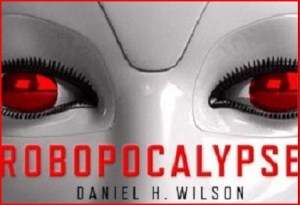
After all, in his nonfiction treatise “How to Survive a Robot Uprising” (2005), Wilson was a deadpan sci-fi genius. I expected much more from this witty robotics expert with a PhD from Carnegie Mellon.

God help the actors - or avatars - who have to deliver these lines. That transition won’t be hard because the short chapters of “Robopocalypse” already read like a series of rough sketches for set designers and animators. Even before Wilson finished inputting his novel, Steven Spielberg bought the film rights and started drafting the storyboard. Even by the cornball standards of the original “Battlestar Galactica,” this is a frakkin’ disaster, a literary version of Windows Me - much hyped but prone to crash.Īs with the inevitable robot rebellion, though, there’s nothing we can do to stop it. Wilson’s novel about computers gone mad to be a work of Proustian sophistication, but the real surprise is what a groaner it is. Watch the videos and then use these questions to facilitate classroom discussions about the topics presented.ĭownload the Video Discussion Guide.With a title like “Robopocalypse,” you don’t expect Daniel H.
The relationships between humans and AIsĮssay Question: Could EPICAC be a precursor to Archos? If the two AI’s shared the same technological DNA, how might EPICAC’s experiences have influenced Archos’s ideas about humanity? Video Discussion Guide. 
Ask students to compare and contrast the following–
 Free-Born Robot – a robot whose consciousness has been liberated from the Master AIĭownload the lesson plan: Robopocalypse Four CournersĪrtificial Intelligence: Then and NowHave students read chapter 1 “Tip of the Spear” from Robopocalypse. Next have them read the short story “EPICAC” by Kurt Vonnegut. Cyborg – A human with robotic enhancements. Have the students write a paragraph or short story from the point of view of their character and have them plan what they would say upon meeting each of the other characters. Break students into four groups and tell them to think from the point of view of one of the characters below. Build a bot that performs the programmed commands you give it.ĭownload the Engineering Design Process Handout Writing Activitiesįour CornersGet students thinking about characterization, point of view, and dialog with a four-corners writing exercise. Examine interesting design concept art for robots and discover best robot features. Learn about the importance of robots and design a robot that can perform a given task while learning about the engineering design process. Idea Sparks and Mini Lessons can also be used for differentiation and to foster new ideas of your own.
Free-Born Robot – a robot whose consciousness has been liberated from the Master AIĭownload the lesson plan: Robopocalypse Four CournersĪrtificial Intelligence: Then and NowHave students read chapter 1 “Tip of the Spear” from Robopocalypse. Next have them read the short story “EPICAC” by Kurt Vonnegut. Cyborg – A human with robotic enhancements. Have the students write a paragraph or short story from the point of view of their character and have them plan what they would say upon meeting each of the other characters. Break students into four groups and tell them to think from the point of view of one of the characters below. Build a bot that performs the programmed commands you give it.ĭownload the Engineering Design Process Handout Writing Activitiesįour CornersGet students thinking about characterization, point of view, and dialog with a four-corners writing exercise. Examine interesting design concept art for robots and discover best robot features. Learn about the importance of robots and design a robot that can perform a given task while learning about the engineering design process. Idea Sparks and Mini Lessons can also be used for differentiation and to foster new ideas of your own. 
These questions, prompts, and short activities provide quick ways to inspire interest and explore the STEAM concepts related to the book.








 0 kommentar(er)
0 kommentar(er)
